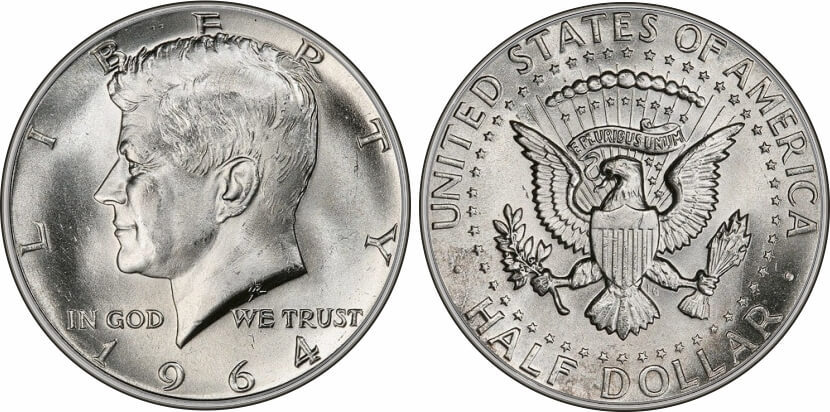Complete Guide to Kennedy Half Dollars
The Kennedy Half Dollar was introduced in 1964 shortly following the assassination of President John F. Kennedy. The swift decision to memorialize the popular president on the denomination also brought a premature conclusion to the Franklin Half Dollar series, which otherwise would have continued for at least another ten years. The new series immediately captured the public’s attention and many pieces were saved from circulation. In part, this inclination to save rather than spend the coins led to a decline in usage for the denomination, which is now rarely seen within commerce. Nonetheless, Kennedy Half Dollars continue to be minted each year, and the series enjoys a wide collector base.
John Fitzgerald Kennedy was born in 1917 in Brookline, Massachusetts. After overcoming several early childhood illnesses, he went on to attend and graduate from Harvard University. He would join the U.S. Naval Reserve and earn the Navy and Marine Corps Medal and a Purple Heart. He went on to serve six years in the House of Representatives and seven years in the U.S. Senate. In 1961 he was inaugurated as the 35th President of the United States, as the youngest person to ever hold the highest office. On November 22, 1963, he was assassinated during an open motor parade in Dallas, Texas. News of the assassination quickly spread, sending shockwaves across the nation.
Within hours after the tragic event, United States Mint Director Eva Adams called Chief Engraver Gilroy Roberts to inform him that a depiction of Kennedy on one of the larger silver coins was already being contemplated. The possible denominations included the quarter, half dollar, and silver dollar. President Kennedy’s widow Jacqueline Kennedy indicated her opposition to replacing George Washington on the quarter, and the silver dollar was dropped from consideration since it had not been produced since 1935. Thus, the half dollar denomination was chosen. A bill was introduced in Congress in December 1963 authorizing Kennedy to appear on the half dollar. At the urging of President Lyndon B. Johnson, the bill was quickly passed on December 30, 1963.
By this time, work had already commenced on the coin design. For the obverse, Gilroy Roberts modified a bust of Kennedy that he had previously created for Kennedy’s Presidential medal. For the reverse, Assistant Engraver Frank Gasparro modified an image of the Presidential Seal that had been used on the same medal. Production of the first Proof coins began in January 1964, followed by ceremonial first strikes for circulating coins at both the Philadelphia and Denver Mints on February 11, 1964.
Design

The obverse design of the coin features a profile portrait of President Kennedy, facing to the left. The inscription “LIBERTY” appears widely spaced above, with the date below. The motto “IN GOD WE TRUST” appears in a straight line above the date, divided by the truncation of the neck. The reverse features an adaptation of the Presidential Seal, featuring the heraldic eagle surrounded by fifty stars. The inscriptions “UNITED STATES OF AMERICA” and “HALF DOLLAR” appear surrounding.
At the onset of the series, massive numbers of Kennedy Half Dollars were produced, with many of the pieces saved or hoarded both domestically and abroad. Amidst a change in composition and reduced usage of the denomination within commerce, mintage levels would gradually decline. Starting in 2002, the coins were no longer be produced for circulation, but struck only in the limited quantities necessary to fulfill demand from collectors. These coins are now issued within various numismatic products sold by the United States Mint at a premium to face value.


